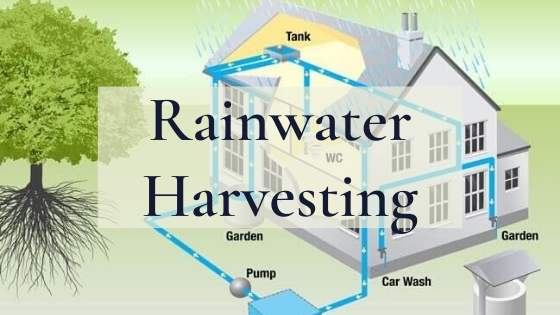
Rainwater harvesting is the process of collection or storage of rainwater with the help of an artificially designed system rather than allowing it to run off naturally or man-made catchment areas like a rooftop, rock surface, semi-pervious land surface.
All living things need water to live and to carry out different activities. It’s hard to imagine a day without water. water is used for a different purpose in daily life activity. Water is an essential and abiotic component of the ecosystem. Due to the lack of water conservation and pollution of water bodies, there will be a scarcity of water. One of the popular method used for conservation of water is rainwater harvesting system.
Methods of Rainwater harvesting
There are mainly two ways of harvesting rainwater, namely:
- surface runoff harvesting
- rooftop rainwater harvesting
Surface runoff harvesting
Surface runoff water harvesting is a method of rainwater harvesting in which stormwater is collected, accumulated, and purified for its ultimate use. Rainwater flows away as surface runoff in developed areas. This runoff can be caught and used for recharging aquifers by acquiring proper methods.
Rooftop Rainwater Harvesting
It is a system of storing rainwater where it falls. In rooftop harvesting, the roof becomes the catchment, and the rainwater is stored from the roof of the house/building.. It can either be accumulated in a tank or redirected to an artificial recharge system. This method is less expensive and very useful and, if implemented correctly, helps in augmenting the groundwater level of the area.
Components of Rainwater Harvesting
The components of the rainwater harvesting system:-
Catchment: The surface which receives the rainwater and provides water to the system is called a catchment area. catchment area can be a finished surface or an unfinished surface like open ground. A galvanized iron or corrugated sheets can be used for water harvesting.
Coarse mesh: Coarse mesh refers to mesh installed at the inlet point to prevent the passage of debris, dried leaves
Gutters: Gutters are channels around the edge of a sloping roof to collect and transport rainwater to the storage tank. It is mostly made from a plain galvanized iron sheet. Gutters need to be supported so they don’t fall off when loaded with water.
Conduits: Conduits are the pipelines which carry rainwater from catchment to harvesting system.
First- flushing: A first flush device is a stopper which makes sure flushing out of the first spell of rain away from the storage tank that carries a larger amount of pollutants from air and catchment surface
Filters: The filter is used to remove suspended pollutants from rainwater collected from roof topwater. Charcoal, horizontal roughing and sand filters are commonly used for commercial purpose.
Storage facility: The storage container is often the most visible or recognizable component of a system. It is where the captured rainwater is redirected to and collected for later use. The main goal of the storage tank is protection.
Recharge structures: Rainwater harvesting recharge structure is the technique of collection and storage of rainwater in subsurface aquifers before it is lost as surface runoff.
Rainwater harvesting is a feasible process that helps in preserving water for future needs. Water scarcity is a major concern in today’s situation. The process of rainwater harvesting is a good way to preserve water.
